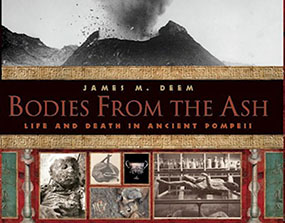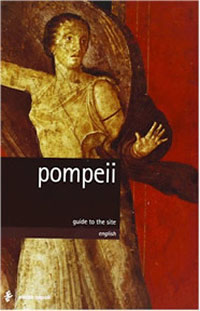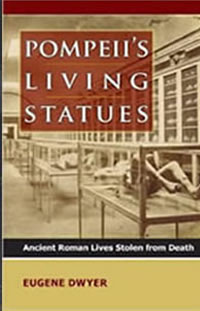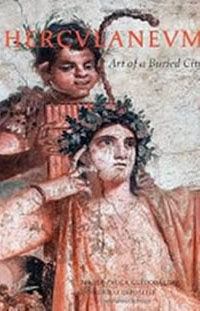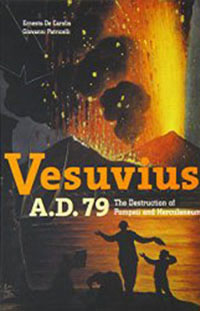Hardcover edition, 2005.Paperback edition, 2017.
|
~~ Suggestions for Visiting Pompeii ~~ ~~ Pompeii's Garden of the Fugitives ~~ ~~ Related Books by James M Deem: Bodies from the Ice ~~ Bodies from the Bog ~~ Faces From the Past ~~ |
Bodies from the Ash: Life and Death in Ancient Pompeii tells the story of the victims of Pompeii.
After Mt. Vesuvius erupted in AD 79, Pompeii lay buried until 12 feet of volcanic ash and debris for the next 1700 years. Some attempts were made to excavate the town, but no one was certain of its exact location. Finally, in the mid-1700s, the town was rediscovered. Along with the desired treasures (statues, marble, jewelry) that excavators sought for wealthy patrons, workers also uncovered many skeletons of people who could not escape. At first, these skeletons were placed in locations within the Pompeian ruins as curiosity objects. Later, under the direction of Giuseppe Fiorelli, the hollow space around some skeletons was used as a mold. Workers poured plaster of Paris into the cavity; when the outer shell of the mold was chipped away, the plaster body of a person remained—an imprint of that person’s last moment alive.
By studying these individuals and the possessions that they had with them, Fiorelli and later scientists attempted to piece together their stories. Bodies from the Ash describes what they have found and the stories they have told.
Honors and Reviews
Best Books for Young Adults 2006 (ALA)
2006 Outstanding Science Trade Book for Students K-12 (National Science Teachers Association and the Children's Book Council) |
School Library Journal Best Children’s Books 2005
2006 Notable Children's Trade Book in the Field of Social Studies (National Council for the Social Studies and the Children's Book Council) |
2006 CCBC Choices (University of Wisconsin-Madison)2006 Orbis Pictus Recommended Book (NCTE)2005 VOYA Nonfiction Honor ListNonfiction Honor List, 2005 Bank Street College Best of the Best (Outstanding Books of 1997 to 2008) |
|
 SCHOOL LIBRARY JOURNAL
SCHOOL LIBRARY JOURNAL
(starred review)
"In A.D. 79, Mount Vesuvius erupted and within 24 hours, ash, pumice, and volcanic rubble had covered, and annihilated, the city of Pompeii. It was not until the 18th century that workers began to uncover the remains of this nearly forgotten, except in legend, city and its inhabitants. In this well-researched account, Deem retells the story of this devastating eruption, combining a lively text with photographs of the bones and artifacts that have been unearthed through the years. In 1863, an excavator discovered a fascinating way to study human remains. As bodies covered in hot ash and enveloped by volcanic material decayed, spaces were left around the skeletons. After the hollow areas were filled with plaster, the surrounding debris was chipped away, resulting in detailed plaster casts that preserved imprints of the people's dying moments, showing their facial expressions and body positions as well as their clothing and possessions. Deem explains how scientists have used these molds and other evidence to piece together the life styles and final moments of some of the victims, and conveys these heart-wrenching tales. Dramatic photographs of the casts capture the horror of this event and help readers to envision day-to-day life in this civilization. With incredibly engrossing images and narrative, this is a powerful and poignant piece of nonfiction."
Children's Literature
"James Deem provides budding archaeologists with this intriguing look at the lost town. The first chapter gives a bit of history and background of the town itself, while the rest of the book is devoted to looking at the town from an archaeological standpoint. Chapter Two details how the city was eventually rediscovered and became one of the most famous archaeological sites in the world. Chapter Three is entirely dedicated to describing how many of the bodies left imprints in the ash, imprints that one could use to create plaster casts of the victims. Chapter Four explains how these casts help historians re-create the last moments of the victims and even tell a bit about their lives. Chapter Five describes the lesser-known town of Herculaneum, also a victim of Vesuvius. The final chapter describes Pompeii in the modern world, from new techniques for creating casts to threats to the city. This detailed yet easily comprehensible text is accompanied by numerous color photographs. A must for any student researching a report on Pompeii."
National Science Teachers Association and Children's Book Council, Outstanding Science Trade Book for Students K-12
"This attractive...volume offers a deeper than usual coverage of the destruction of Pompeii by a volcano in the first century A.D. ...[L]etters from a Roman historian provide actual accounts of the timeline and the stages of the eruption, making this book appropriate as a supplement to Earth science content related to volcanism.... The book is ideal for the development of interdisciplinary thematic units, blending science, social studies, and geography in middle school...."
School Library Journal, Curriculum Connections
"Kids...will be mesmerized by James M. Deem’s Bodies from the Ash: Life and Death in Ancient Pompei. Gripping, vividly written chapters provide a thorough recounting of the eruption; a summary of the city’s rediscovery by archaeologists centuries later; descriptions of chillingly lifelike plaster casts taken of Vesuvius’s victims; heart-wrenching stories about people’s last moments, based on information gleaned from their remains; and events in nearby Herculaneum...."
The Center of Children's Literature (Carthage College)
"An oversized, horizontal orientation, with many black and white photos (some from earlier eras in which curious tourists flocked to the city), recent full color photos, maps, and additional information presented in marginalia has resulted in an exemplary production. Wide margins set off the concentrated amount of information, including sequence details drawn from the writing of Younger Pliny, whose uncle died in the eruption. The mistaken idea that lava flow did the destruction is corrected in the detailed description of the deluge of ash and pumice with surges of superhot gasses, which exceeded 900 degrees, Fahrenheit. When excavations began in 1709, diggers discovered the deposits reached a depth of 12 feet. This is also a story of the changing nature of excavations and conservation of remains from earliest digging when sites were looted of valuables and many skeletal remains inadvertently destroyed. Giuseppe Fiorelli made the breakthrough that if plaster casts of the skeletons were made, rather than removing them, much more accurate information about time and location of death, could be available. The effects of the eruption on nearby Herculaneum are described: though wind conditions allowed many residents to escape, subsequent eruptions leveled the city, depositing up to 65 feet of volcanic deposits, which during the l980s revealed over 300 skeletal remains. The book closes with a perplexing note: even though Vesuvius remains a potential threat, over l million people live in its vicinity today- a disaster waiting to happen? The elegant production job is sure to engage many curious child readers in a time period and event few will know until they are lucky enough to discover this book."
Bulletin of the Center for Children's Books
"Ever since the ruins of Herculaneum and Pompeii were re-exposed in the eighteenth century, spectators have been morbidly fascinated by the remains and traces of victims caught at the instant of death. Deem looks at the disaster itself (which he revisits in considerably grim detail), at archaeological practices at the sites over time, and at tourists' experiences of the sites. This book also examines the evidence scientists use to reconstruct the deadly timeline of the A.D. 79 eruption of Mt. Vesuvius and to determine why some fleeing or trapped citizens left skeletal remains, while others left fossil-style depressions from which the now famous plaster casts were made. Plentiful illustrations, the majority in black and white, are sharply reproduced and utterly captivating. Deem concludes with a chapter on the present state of neglect at the excavation and the peril which artifacts face now that they are exposed to the elements...."
Kirkus Reviews
"This fascinating exploration of the buried city of Pompeii begins with a recreation of the catastrophic eruption of Vesuvius and ends with a snapshot of Pompeii today. In between are packed details of the various excavations that have led to our current knowledge of both the life and death of the city. Weaving in the contemporary account of Younger Pliny and the archaeological evidence, the narrative meticulously describes the effects of the various stages of the eruption on the inhabitants and the topography of Pompeii and its neighboring communities. The city's rediscovery receives equally careful coverage, a whole chapter covering Giuseppe Fiorelli's revolutionary technique of creating plaster casts of the victims from the cavities left by their bodies. Avoiding the opportunity to sensationalize, Deem's consistently respectful treatment places the humanity of the victims at the fore...."
